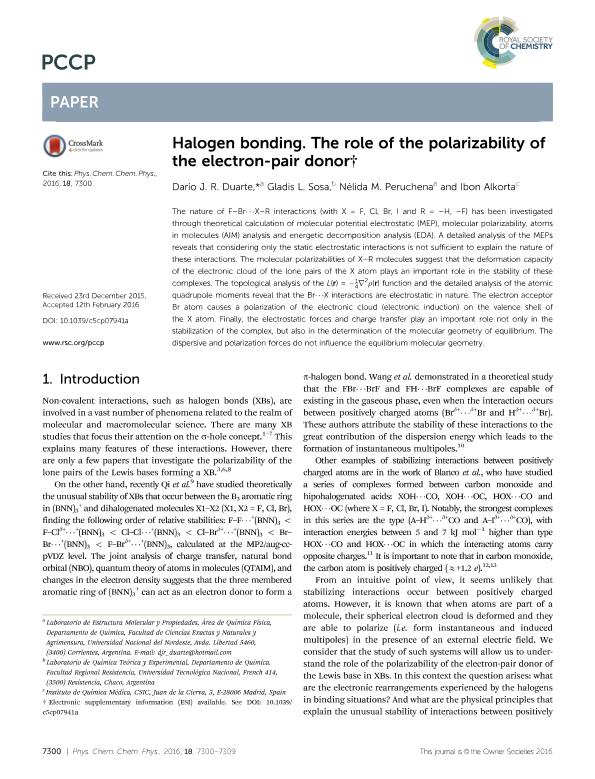Mostrar el registro sencillo del ítem
dc.contributor.author
Duarte, Darío Jorge Roberto

dc.contributor.author
Sosa, Gladis Laura

dc.contributor.author
Peruchena, Nelida Maria

dc.contributor.author
Alkorta, Ibon

dc.date.available
2018-03-20T20:51:34Z
dc.date.issued
2016-02
dc.identifier.citation
Duarte, Darío Jorge Roberto; Sosa, Gladis Laura; Peruchena, Nelida Maria; Alkorta, Ibon; Halogen bonding: the role of the polarizability of the electron-pair donor; Royal Society of Chemistry; Physical Chemistry Chemical Physics; 18; 10; 2-2016; 7300-7309
dc.identifier.issn
1463-9076
dc.identifier.uri
http://hdl.handle.net/11336/39439
dc.description.abstract
The nature of F-Br⋯X-R interactions (with X = F, Cl, Br, I and R = -H, -F) has been investigated through theoretical calculation of molecular potential electrostatic (MEP), molecular polarizability, atoms in molecules (AIM) analysis and energetic decomposition analysis (EDA). A detailed analysis of the MEPs reveals that considering only the static electrostatic interactions is not sufficient to explain the nature of these interactions. The molecular polarizabilities of X-R molecules suggest that the deformation capacity of the electronic cloud of the lone pairs of the X atom plays an important role in the stability of these complexes. The topological analysis of the L(r) = -∇2ρ(r) function and the detailed analysis of the atomic quadrupole moments reveal that the Br⋯X interactions are electrostatic in nature. The electron acceptor Br atom causes a polarization of the electronic cloud (electronic induction) on the valence shell of the X atom. Finally, the electrostatic forces and charge transfer play an important role not only in the stabilization of the complex, but also in the determination of the molecular geometry of equilibrium. The dispersive and polarization forces do not influence the equilibrium molecular geometry.
dc.format
application/pdf
dc.language.iso
eng
dc.publisher
Royal Society of Chemistry

dc.rights
info:eu-repo/semantics/openAccess
dc.rights.uri
https://creativecommons.org/licenses/by-nc-sa/2.5/ar/
dc.subject
Halogen Bond
dc.subject
Qtaim
dc.subject
Laplacian
dc.subject
Mep
dc.subject.classification
Otras Ciencias Químicas

dc.subject.classification
Ciencias Químicas

dc.subject.classification
CIENCIAS NATURALES Y EXACTAS

dc.title
Halogen bonding: the role of the polarizability of the electron-pair donor
dc.type
info:eu-repo/semantics/article
dc.type
info:ar-repo/semantics/artículo
dc.type
info:eu-repo/semantics/publishedVersion
dc.date.updated
2018-03-09T18:46:20Z
dc.journal.volume
18
dc.journal.number
10
dc.journal.pagination
7300-7309
dc.journal.pais
Reino Unido

dc.journal.ciudad
Cambridge
dc.description.fil
Fil: Duarte, Darío Jorge Roberto. Universidad Nacional del Nordeste. Facultad de Ciencias Exactas y Naturales y Agrimensura. Departamento de Química. Laboratorio de Estructura Molecular y Propiedades; Argentina. Consejo Nacional de Investigaciones Científicas y Técnicas. Centro Científico Tecnológico Conicet - Nordeste; Argentina
dc.description.fil
Fil: Sosa, Gladis Laura. Universidad Tecnológica Nacional. Facultad Regional Resistencia. Departamento de Ingeniería Química. Laboratorio de Química Teórica y Experimental; Argentina
dc.description.fil
Fil: Peruchena, Nelida Maria. Consejo Nacional de Investigaciones Científicas y Técnicas. Centro Científico Tecnológico Conicet - Nordeste; Argentina. Universidad Nacional del Nordeste. Facultad de Ciencias Exactas y Naturales y Agrimensura. Departamento de Química. Laboratorio de Estructura Molecular y Propiedades; Argentina
dc.description.fil
Fil: Alkorta, Ibon. Consejo Superior de Investigaciones Científicas. Instituto de Química Médica; España
dc.journal.title
Physical Chemistry Chemical Physics

dc.relation.alternativeid
info:eu-repo/semantics/altIdentifier/url/http://pubs.rsc.org/en/content/articlelanding/2016/cp/c5cp07941a#!divAbstract
dc.relation.alternativeid
info:eu-repo/semantics/altIdentifier/doi/http://dx.doi.org/10.1039/c5cp07941a
Archivos asociados
